Bringing a curly hair tarantula into your home is an exciting experience. These gentle giants are relatively easy to care for, but providing the right food is essential for their health and well-being. Understanding what curly hair tarantulas eat is the first step in ensuring your pet thrives. Unlike many other pets, their diet is straightforward, focusing primarily on insects. This guide explores the top food choices for your curly hair tarantula, feeding frequency, and important considerations for their overall care. Get ready to discover the best way to keep your tarantula happy and healthy.
What Curly Hair Tarantulas Eat
The diet of a curly hair tarantula in the wild consists of whatever they can catch. In captivity, however, the diet needs to be managed to make sure the spider gets enough food. The core of a curly hair tarantula’s diet should be a variety of insects that are readily available and nutritious. Avoid feeding your tarantula food that is too large for it, as this may cause injury. It’s also very important to make sure the insects you feed your spider are free of pesticides. Below are the most common and recommended food choices. This is a list of the top 5 that many keepers use. A well-rounded diet contributes to their growth, molting process, and overall lifespan. It is important to vary the diet to ensure the tarantula gets a good range of nutrients.
Crickets and Roaches
Crickets and roaches are staples in the curly hair tarantula’s diet, thanks to their availability and nutritional value. They are a convenient food source, easily found at most pet stores. The size of the insect should be appropriate for the tarantula’s size; the general rule is to feed insects that are no larger than the tarantula’s body (excluding legs).
Nutritional Value of Crickets

Crickets offer a good source of protein, which is crucial for the tarantula’s growth and development. They also contain essential nutrients like chitin, which supports the exoskeleton. However, the nutritional value of crickets can vary depending on their diet. It’s best to ‘gut-load’ crickets (feeding them nutritious food) before offering them to your tarantula to maximize their benefits.
Roaches as a Food Source
Roaches are another excellent option, often preferred by some keepers. They are usually meatier than crickets, providing a more substantial meal. Roaches such as Dubia roaches are particularly popular due to their high protein content and ease of breeding. Like crickets, they should be gut-loaded to enhance their nutritional value. Roaches are also known for being less prone to escape and easier to manage within the enclosure.
Mealworms and Superworms
Mealworms and superworms are other popular choices, offering a change of pace from crickets and roaches. They’re easily found at pet stores and online retailers. Both can be a valuable addition to a tarantula’s diet, but it’s essential to understand their nutritional profiles.
Mealworm Nutritional Content

Mealworms provide a good source of protein and are relatively easy to store. However, they have a high-fat content, so they should be given in moderation. Excessive fat can lead to health problems for the tarantula. They are a good supplementary food but should not be the primary diet.
Superworms for Curly Hair Tarantulas
Superworms are larger than mealworms and offer more protein. They also have a higher fat content, similar to mealworms, so they should also be given in moderation. They may be a good option for larger tarantulas. Always monitor your tarantula’s condition and adjust the feeding accordingly.
Other Insect Options
In addition to the staples, other insects can be offered to provide variety. Variety in the diet can help ensure your tarantula receives a range of nutrients and prevents it from becoming bored with its food. It’s also a good idea to know what your tarantula likes and dislikes, as this can change over time. Consider the following options:
Waxworms for Occasional Treats

Waxworms are high in fat and should only be offered sparingly, as a treat. They can be a good way to entice a tarantula that isn’t eating well, but frequent consumption can lead to obesity.
The Benefits of Feeding Different Insects
Different insects offer different nutritional profiles. Varying the diet can provide a more complete range of nutrients. It also keeps the tarantula’s diet interesting and prevents it from developing preferences for one type of food. Always research new food options before introducing them to your tarantula.
Pre-killed vs. Live Prey
There’s a debate among tarantula keepers about whether to feed live or pre-killed prey. Both methods have their pros and cons, and the best choice often depends on the individual tarantula and the keeper’s preferences. Safety for the tarantula and the keeper should always be the top priority.
Advantages of Pre-killed Prey

Pre-killed prey eliminates the risk of the insect biting or harming the tarantula. This is particularly important for young or vulnerable tarantulas. It also allows the keeper to monitor how much the tarantula eats. Pre-killing is a practical option for those who may find live feeding unsettling. The prey can be killed humanely beforehand and then offered with tongs.
Advantages of Live Prey
Live prey provides natural hunting behavior, which can be stimulating for the tarantula. Some keepers believe it encourages a healthier, more active lifestyle. However, you should always supervise live feeding. Ensure the prey is consumed quickly to minimize the risk of injury to the tarantula. Also, be prepared to remove uneaten prey after 24 hours.
How Often to Feed a Curly Hair Tarantula
Feeding frequency depends on the tarantula’s age and size. Young tarantulas need more frequent feedings. Adult tarantulas may require less food. The following guidelines can help:
Feeding Frequency Based on Age

Spiderlings (young tarantulas) can be fed 2-3 times per week. Juvenile tarantulas can be fed 1-2 times per week. Adult tarantulas can be fed every 1-2 weeks, depending on their appetite and condition. Adjust the feeding schedule based on the tarantula’s abdomen size. A healthy tarantula will have a plump abdomen. Reduce feeding if the abdomen becomes too large. Monitor your tarantula’s eating habits and adjust accordingly, as some tarantulas eat more or less.
Signs of Overfeeding
Overfeeding can be detrimental to a tarantula’s health. Signs of overfeeding include a very large abdomen, refusal to eat, and lethargy. If you suspect overfeeding, reduce the amount and frequency of meals. Always remove uneaten food within 24 hours to prevent mold and mites from forming in the enclosure.
Water and Hydration for Your Tarantula
Providing fresh water is just as important as feeding your curly hair tarantula. Water is essential for their survival, helping them stay hydrated and enabling important biological processes. Clean water also helps with molting. Make sure you provide clean, fresh water at all times.
Importance of Fresh Water

Water should be available in a shallow dish. Change the water frequently, ideally every 1-2 days, to prevent bacteria and mold growth. Use a shallow water dish to prevent the tarantula from drowning. The size of the water dish should be appropriate for the tarantula’s size. Clean the water dish regularly with warm water and soap, rinsing well to remove any residue.
Maintaining Humidity
In addition to water, maintaining proper humidity levels is crucial. Curly hair tarantulas need a moderate humidity level to molt successfully. This can be achieved by misting the enclosure lightly, or by keeping a portion of the substrate damp. Monitoring the humidity levels with a hygrometer is recommended to ensure they are within the appropriate range. Ventilation is also important to prevent mold growth; so the enclosure must be kept properly ventilated.
In conclusion, feeding your curly hair tarantula is a straightforward process that requires knowledge of their dietary needs and consistency. Crickets, roaches, mealworms, and superworms form a solid foundation for a healthy diet, supplemented with other insects for variety. Providing fresh water and maintaining proper humidity are also crucial for their well-being. By understanding what curly hair tarantulas eat and implementing these practices, you can ensure your pet lives a long, healthy, and happy life. Remember to always observe your tarantula’s behavior and adjust your feeding and care accordingly.
